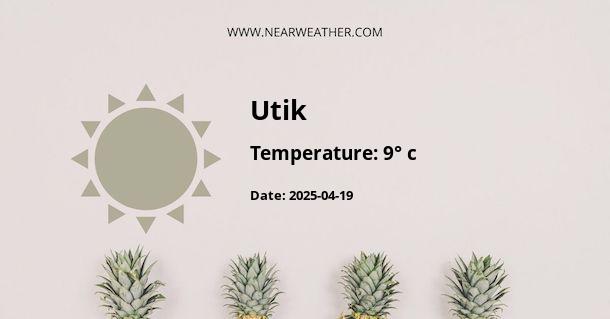An In-Depth Look at Uhk, SI Climate and Year-Round Weather Patterns
The region of Uhk in SI (Slovenia) is known for its diverse climate, influenced by its varied geography which includes Alpine, Mediterranean, and Pannonian plains. Understanding its weather patterns and regional climate is essential for agriculture, tourism, and daily life. In this detailed analysis, we will explore the typical weather conditions travelers and residents can expect throughout the year.
Geographical Influence on Climate
The climatic variations in Uhk, with its proximity to the Alps and the Mediterranean, make it a region with a myriad of microclimates. The Alpine climate impacts the northern part of Uhk, while the southern regions are more influenced by the warm Mediterranean breezes.
Seasonal Climate Overview
Uhk experiences a temperate climate with four distinct seasons—spring, summer, autumn, and winter—each bringing unique weather patterns that impact the region's natural environment and the lifestyle of its inhabitants.
Spring Weather Patterns
In Uhk, spring is characterized by rising temperatures and unpredictable weather. This transition period can bring about sudden changes that range from warm sun to rain showers.
- March: The chance of precipitation decreases, but the temperatures can still vary widely from day to day.
- April: Temperatures become milder; however, April showers are not uncommon as moisture-laden systems move through the area.
- May: Warmer weather settles in, but late frost is a possibility, especially in the higher elevations.
Temperature and Precipitation Tables
To offer a clearer picture of the spring weather in Uhk, we provide a detailed temperature and precipitation table. Please note that these are historical averages and actual conditions may vary.
| Month | Average High (°C) | Average Low (°C) | Average Precipitation (mm) |
|---|---|---|---|
| March | 10 | 0 | 60 |
| April | 15 | 5 | 70 |
| May | 20 | 10 | 80 |
Summer Climate Trends
The summer months in Uhk bring an overall warm climate, with higher temperatures and increased tourist activity due to favorable weather conditions.
- June: The beginning of the tourist season, as temperatures are comfortable and days are longer.
- July: Usually the warmest month of the year, it can also experience occasional thunderstorms due to increased humidity.
- August: Similar to July, with a slight decrease in precipitation towards the end of the month.
Temperature and Precipitation Charts
Summer weather statistics are illustrated here to provide an insight into regional expectations:
| Month | Average High (°C) | Average Low (°C) | Average Precipitation (mm) |
|---|---|---|---|
| June | 25 | 15 | 100 |
| July | 27 | 17 | 95 |
| August | 27 | 16 | 90 |
Autumn Weather Overview
Autumn is a transition period towards cooler temperatures, with the landscape changing colors in a picturesque display. The seasonal adjustment also brings a gradual increase in precipitation.
- September: The warm temperatures begin to cool, and the decreasing daylight hours signal the end of the high tourist season.
- October: A significant drop in temperatures, with increased rainfall and chances of the first frost.
- November: Colder still, with the likelihood of the first snowfall in the northern areas near the Alps.
Temperature and Precipitation Tables
Autumn weather patterns are outlined in the following table:
| Month | Average High (°C) | Average Low (°C) | Average Precipitation (mm) |
|---|---|---|---|
| September | 20 | 10 | 85 |
| October | 15 | 6 | 100 |
| November | 8 | 2 | 120 |
Winter Climate Characteristics
Winters are typically cold with snowfall, particularly in the mountainous regions, affecting outdoor activities and creating opportunities for winter sports.
- December: The official start of winter, with short days and the landscape often blanketed in snow.
- January: Generally the coldest month, with sub-zero temperatures and the highest snowfall probabilities.
- February: Continuing cold weather with a gradual increase in daylight, hinting at the approaching spring.
Temperature and Precipitation Charts
The harsh winter conditions in Uhk are best understood by analyzing the following data:
| Month | Average High (°C) | Average Low (°C) | Average Precipitation (mm) |
|---|---|---|---|
| December | 3 | -3 | 100 |
| January | 1 | -5 | 90 |
| February | 3 | -4 | 70 |
Year-Round Climate Considerations
It is important for those planning to visit or live in Uhk to consider the regional microclimates and weather aberrations, such as the Bora winds, which can impact the Adriatic coast with gusty conditions. The interplay of land and sea, as well as elevation variations, culminates in weather patterns that exhibit complexity beyond simple seasonal averages.
Expert Opinions and Research
Climatologists suggest that climate change is impacting Uhk's weather patterns, leading to more extreme weather events and altering the traditional views on seasonal norms. Ongoing research provides essential insights into future trends, with practical implications for agriculture, infrastructure planning, and disaster management.
Conclusion
Comprehensive knowledge of Uhk's climate reveals a picture of a region with a dynamic interplay of weather patterns. Seasonally, Uhk offers a range of conditions from the Alpine chill to the Mediterranean warmth, shaping its natural beauty and the lifestyle of its residents. Travelers and citizens alike can use this detailed climate and weather guide to make informed decisions for planning events, agricultural activities, and enjoying all that the region has to offer.
A - Utik's Latitude is 46.170559 & Longitude is 14.509720.
A - Weather in Utik is 9° today.
A - Climate Conditions in Utik shows broken clouds today.
A - Humidity in Utik is 89% today.
A - Wind speed in Utik is 3.71 km/h, flowing at 280° wind direction. today.
